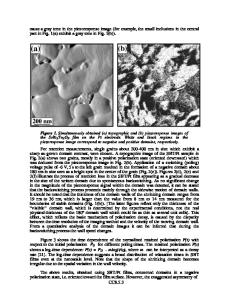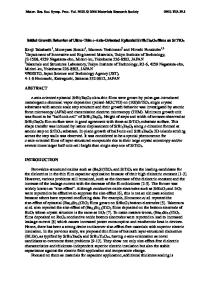Growth and Microstructure of SrBi 2 Ta 2 O 9 thin films
- PDF / 1,498,595 Bytes
- 6 Pages / 417.6 x 639 pts Page_size
- 73 Downloads / 358 Views
2
Abstract Single phase, (00/) oriented SrBi 2Ta 2 O9 (SBT) thin films have been deposited on (100) MgO substrates using pulsed laser deposition(PLD) technique. In order to study the influence of the growth conditions on the microstructure and stoichiometry, SBT film growth was carried out under different deposition conditions, using an Kr:F excimer laser (248 nm, 30 ns FWHM). Effect of laser fluence(0.75-2 J/cm 2), frequency of the laser pulse (4-10 Hz), substrate temperature (700850'C), oxygen partial pressure(150-450 mTorr) have been studied using X-ray diff-raction(XRD), Scanning Electron Microscope(SEM), X-ray energy dispersive analysis (EDAX), atomic force microscopy(AFM). It was found that small variation in growth temperature and oxygen pressure has a large influence on the average grain size (50-180 nm) and surface roughness (0.14-0.3 nm) respectively. Outgrowths on the film surface were observed at high substrate temperatures, high laser energy and with higher frequencies (>6) of the laser pulse. Highly c-axis oriented SBT thin films with homogeneous surface morphology and with an average surface roughness of 0.14 nm were deposited at 750 'C, 260 mTorr 02 pressure and 1.25 J/cm 2 laser fluence. These films have a tangent loss around 0.05 and dielectric constant around 417 with a tunability of 4% in the microwave frequency region (1-20 GHz). Introduction
Bismuth layer structured ferroelectric thin films, such as SBT, have become promising materials for
random access memories because of their fatigue free nature exceeding lxlO12 read/write cycles. Other important characteristics of SBT films are low relative permittivity, a low coercive field, long retention, minimum tendency to imprint and low leakage current. [1-6]. SBT films were deposited using pulsed laser deposition (PLD) [3,4] metalorganic decomposition [5,6], MOCVD [7], and sputtering [8] methods. However, lowering the process temperature and increasing the remnant polarization are highly desirable to SBT films an acceptable alternative to PZT films for memory applications. It is not clear whether PLD will be a suitable technique for application to a manufacturing process, yet it is a very interesting technique for doing basic research. It is very important to understand the influence of growth parameters on the microstructure and surface morphology of the films in order to obtain device quality films. In this paper, we report a study on the growth and microstructure of SBT films on (100) MgO substrate using PLD technique to realize how the growth conditions such as substrate temperature and oxygen pressure, influence the microstructure of the SBT films. Dielectric properties at microwave frequency(I-20 GHz) were measured using interdigitated capacitors.
131 Mat. Res. Soc. Symp. Proc. Vol. 574 • 1999 Materials Research Society
Fig. 1 XRD pattern of SBT film deposited at various substrate temperatures 700'C
___ 750'c
C
-pure
A 1oo(1c(06 (.,)
10
15
(...(. 20
(116)
30
35
4
20
Fig 2. XRD patterns of SBT films deposited
(004)
Watt qu
Data Loading...











